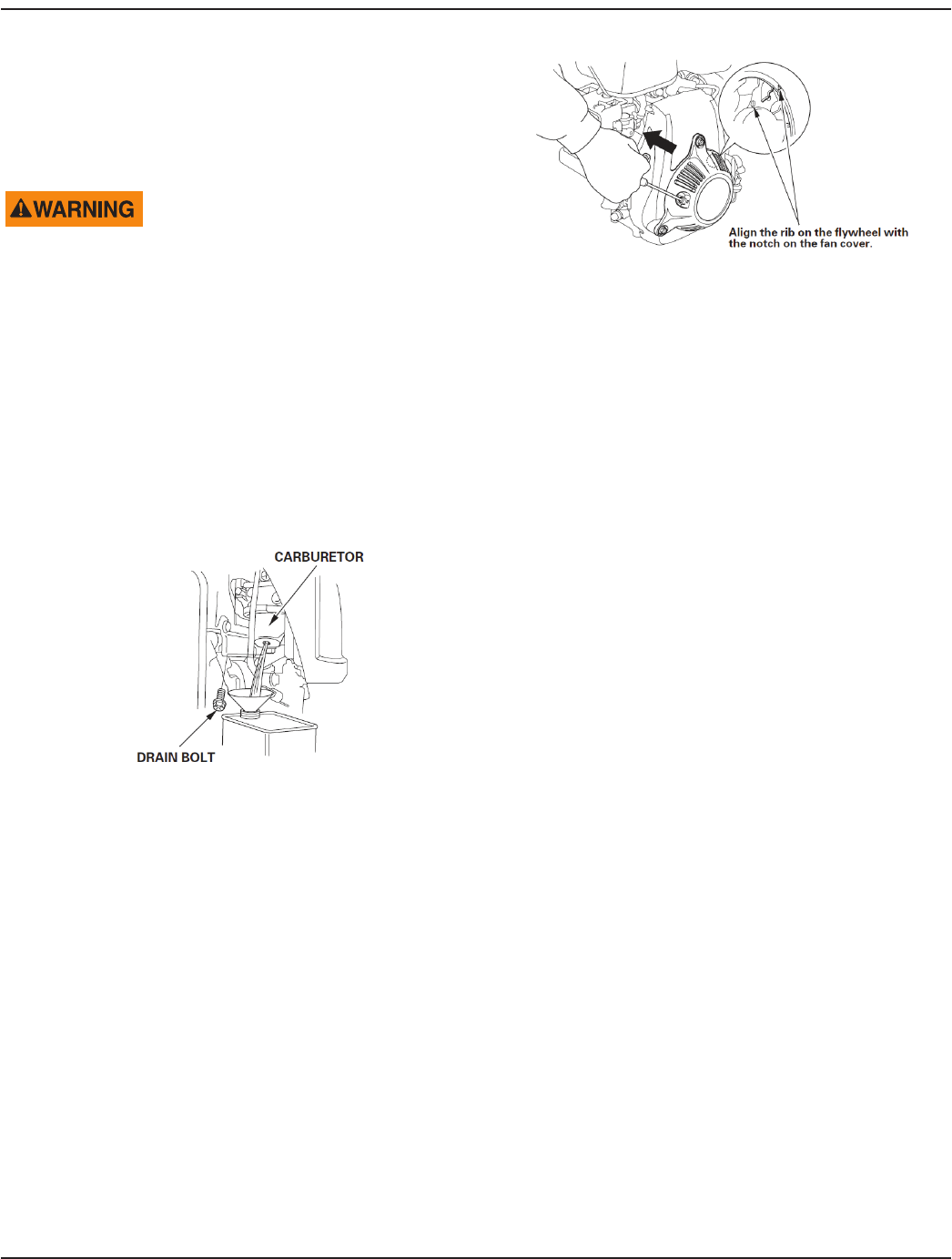Manual
Table Of Contents
- Safety
- Benefits of Vibration
- Head and Shaft Selection
- Adjusting the Backpack
- Pre-Operation Checks
- Operation
- Maintenance
- Servicing the Engine
- Troubleshooting
- Service
- Parts
- Honda Engine Parts
- Honda Engine Warranty
- Wyco Warranty
- Wyco Drawings
- W402535 Backpack Assembly
- W402530 Frame Assembly
- W402600 Speed Increaser Assembly, 1 of 4
- W402600 Speed Increaser Assembly, 2 of 4
- W402600 Speed Increaser Assembly, 3 of 4
- W402600 Speed Increaser Assembly, 4 of 4
- W402316 Replacement Clutch Kit
- W402630 Quick Disconnect Adapter

User Manual
Page 15 March 2014
2. After adding a gasoline stabilizer, run the engine
outdoors for 10 minutes to be sure that treated gasoline
has replaced the untreated gasoline in the carburetor.
3. Stop the engine, and move the fuel valve lever to the
OFF position.
Draining the Fuel Tank and Carburetor
GASOLINE IS HIGHLY FLAMMABLE AND EXPLOSIVE, AND
YOU CAN BE BURNED OR SERIOUSLY INJURED WHEN
HANDLING FUEL.
• STOP ENGINE AND KEEP HEAT, SPARKS, AND FLAME
AWAY.
• HANDLE FUEL ONLY OUTDOORS.
• WIPE UP SPILLS IMMEDIATELY.
1. Place an approved gasoline container below the
carburetor, and use a funnel to avoid spilling fuel.
2. Drain the fuel tank and carburetor.
Remove the carburetor drain bolt, then move the fuel
valve to the ON position.
3. After all the fuel has drained into the container, reinstall
the drain bolt (carburetor equipped with a drain bolt type
only). Tighten the drain bolt or drain screw securely.
Engine Oil
Change the engine oil (see “Engine Oil” on page12).
Engine Cylinder
1. Remove the spark plug (see “Spark Plug” on page13).
2. Pour a tablespoon 5…10 cm
3
(5…10 cc) of clean engine
oil into the cylinder.
3. Pull the starter grip several times to distribute the oil in
the cylinder.
4. Reinstall the spark plug.
5. Pull the starter grip slowly until resistance is felt and the
rib on the ywheel aligns with the notch on the fan cover.
This will close the valves so moisture cannot enter the
engine cylinder. Return the starter grip gently.
Storage Precautions
If your engine will be stored with gasoline in the fuel tank
and carburetor, it is important to reduce the hazard of
gasoline vapor ignition. Select a well-ventilated storage area
away from any appliance that operates with a flame, such as
a furnace, water heater, or clothes dryer. Also avoid any area
with a spark-producing electric motor, or where power tools
are operated.
If possible, avoid storage areas with high humidity, because
that promotes rust and corrosion.
Keep the engine level in storage. Tilting can cause fuel or
oil leakage.
With the engine and exhaust system cool, cover the engine
to keep out dust. A hot engine and exhaust system can
ignite or melt some materials. Do not use sheet plastic as a
dust cover.
A nonporous cover will trap moisture around the engine,
promoting rust and corrosion.
Removal from Storage
Check your engine as described in “Is Your Engine Ready to
Go?” on page7.
If the fuel was drained during storage preparation, fill the
tank with fresh gasoline. If you keep a container of gasoline
for refueling, be sure it contains only fresh gasoline. Gasoline
oxidizes and deteriorates over time, causing hard starting.
If the cylinder was coated with oil during storage
preparation, the engine will smoke briefly at startup. This
is normal.
Transporting
If the engine has been running, allow it to cool for at least 15
minutes before loading the engine-powered equipment on
the transport vehicle. A hot engine and exhaust system can
burn you and can ignite some materials.
Keep the engine level when transporting to reduce the
possibility of fuel leakage. Turn the fuel valve to the OFF
position (see “Pre-Operation Checks” on page7).










